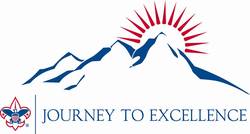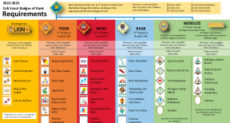 In the last article we discussed the overall reorganization of the Journey to Excellence scorecards for 2015 and detailed the changes in the Cub Scout checklist.
In the last article we discussed the overall reorganization of the Journey to Excellence scorecards for 2015 and detailed the changes in the Cub Scout checklist.
Now, let’s look at the changes awaiting Boy Scout troops as they embark on their 2015 Journey to Excellence.
Boy Scouting
As with the pack JTE form, the troop scorecard for 2015 has been reorganized into functional divisions with goals that interrelate and are a bit easier to follow. The Fitness and Charter Renewal evaluation items were eliminated and a check box added to indicate an on-time charter renewal pledge.
Planning and Budget
- #1 Planning and Budget, formerly item 10 and incorporating planning points from 2014’s item 7, Patrol Method. The Bronze level moves from the former Patrol Method item and stipulates committee approval of the budget. The Silver level requires that the troop committee meets six times during the year, and the Gold level incorporates youth involvement in program planning, also previously contained in item 7.
Membership
- #2 Building Boy Scouting, formerly item 3. Bronze is essentially the same except to eliminate the alternative of having at least 15 members (a troop must now recruit at least one member to qualify). Silver and Gold remain the same (increase by 5 or 10 percent, or have at least 25 or 35 members).
- #3 Retention, formerly item 2. For Bronze, only an increase is needed if reregistration is less than 75 percent, but requirements are a bit more stringent for Silver and Gold. Silver requires 80 percent reregistration and Gold requires 85 percent, with no option to have a lower percentage but show a 2% increase.
- #4 Webelos-to-Scout Transition, formerly item 9. The Bronze requirement to hold joint activities with a pack or Webelos den continues but without the requirement that one is a parent orientation and camp promotion. Silver and Gold are the same.
Program
- #5 Advancement, formerly item 1. As with Retention, Bronze requires only a show of improvement if the minimum 40 percent of Scouts advancing isn’t reached, and for Silver and Gold, a minimum cutoff for advancement (50% for Silver, 60% for Gold) is higher than the 2014 specification, and no provision for lesser numbers with improvement.
- #6 Short-term camping, formerly item 5. No change.
- #7 Long-term camping, formerly item 6. Also no change, except for the added objective that a majority of the troop participate.
- #8 Service projects, formerly item 8. One fewer service project is required in each of the three categories (three for Bronze, four for Silver and five for Gold).
- #9 Patrol method, formerly item 7. Added is the objective of developing youth leadership. The requirement to conduct patrol leader training moves from Bronze to Silver, and the Gold allows other advanced training courses besides National Youth Leadership Training (the example given is attendance at an Order of the Arrow Conference). Certainly the National Advanced Youth Leadership Experience or the OA’s National Leadership School would also qualify. Other provisions stay the same.
Volunteer Leadership
- #10 Leadership and family engagement and #11 Trained Leadership are a mash-up of the previous requirements 4 (Trained Leadership) and 11 (Courts of Honor/Parent meetings):
| 2014 Requirement | 2015 Requirement |
| 4 Bronze (Have a Scoutmaster & Assistant, plus a committee of at least 3) | 10 Bronze |
| 11 Bronze (Hold two courts of honor and review plans with parents) | 10 Silver |
| 11 Silver (Hold three courts of honor) | 10 Gold |
| 4 Silver (50% of direct leaders are Trained) | 11 Silver |
| 4 Gold (Two-thirds of committee are Trained, plus one Wood Badge-trained adult registered) | 11 Gold |
- The national Journey to Excellence team must have recognized that many otherwise high-performing troops only conduct three courts of honor annually, rather than the four considered a best practice; therefore, two are required for Silver and three for Gold under requirement 10. In addition, a new Bronze Trained Leadership requirement stipulates that the Scoutmaster and Assistant Scoutmasters must complete an orientation as well as Youth protection Training – as with Cubs, there’s no clarification as to what constitutes an orientation. Fast Start would most likely qualify.
Categories and Point Values
Again, as with the Cub Scout pack tally, there are fewer line items so the number of points required to qualify at each level has dropped, with some redistribution among the requirements. Greater emphasis is placed on planning and budget, short-term and long-term camping, the patrol method, and leadership and family engagement.
The objective of Journey to Excellence is to encourage and recognize units for providing a quality program. A troop or pack that is well-run and is successful in engaging its Scouts and families will have no trouble qualifying. Your Unit Commissioner is a valuable resource when it comes to evaluating your unit’s performance and for obtaining guidance on how to improve the experience for your members.
This post first appeared on Bobwhite Blather.




Does anyone know if anyone has collected enough data to show that Journey to Excellence is actually creating more high performing units, or at least getting more units closer to high performing status?
Just wondering …..
Steve,
I reached out to the national Journey to Excellence Team with your question, and heard back from Neil Lupton, one of the team members. Neil said that they review the data every summer and tweak the requirements to try to get a better picture each year. Neil believes the JTE program has helped units improve the quality of their programs and that the data substantiates it. He also raises the possibility that things might be worse if JTE had not come into use. Neil also shared with me some insight into the ongoing development of the JTE program, which I hope to summarize in a future article. You ask a very good question and it looks like JTE is making a positive difference.